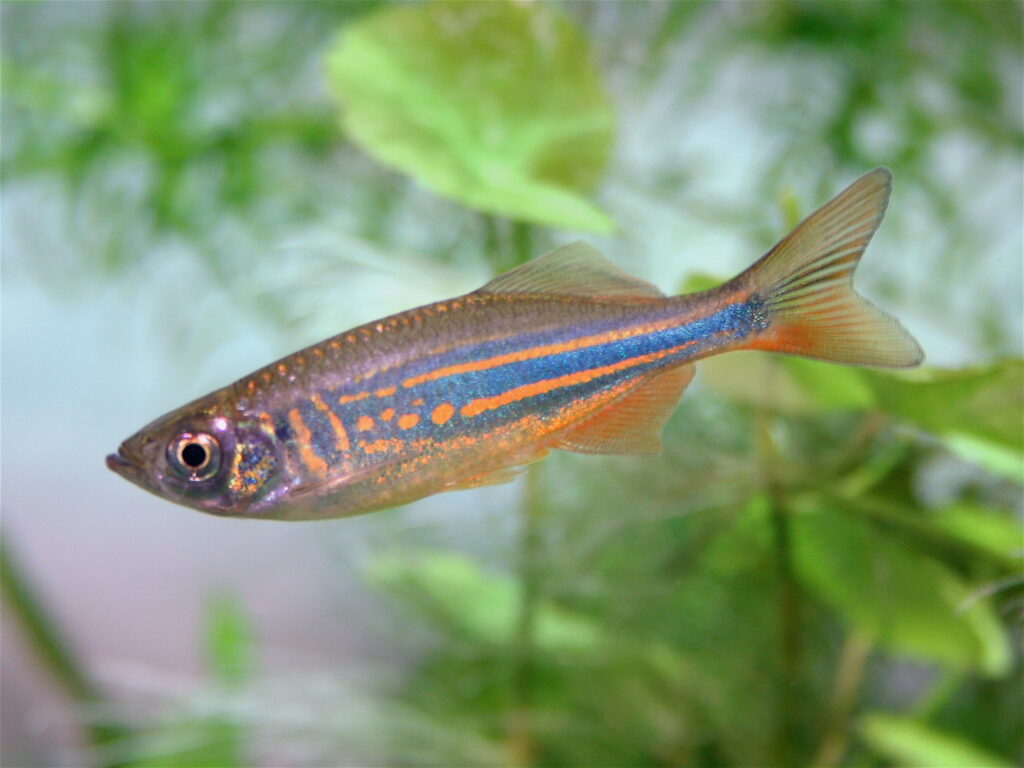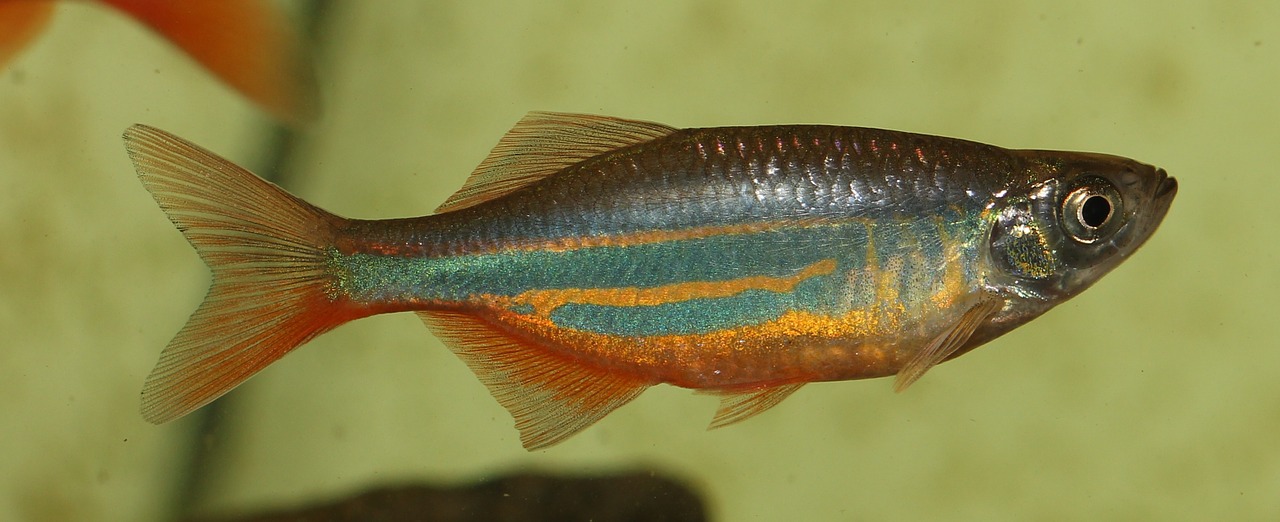Giant Danio
The Giant Danio – Devario aequipinnatus, is a member of the Cyprinidae family and is a perfect addition to an aquarium full of large fish such as Cichlids. These fish are very striking with their vibrant colors and lively demeanor, making them a joy to watch. Originating from South and Southeast Asia, they are very robust and low-maintenance, making them perfect for aquariums. As a strong swimmer and known to jump, ensure your aquarium has a secure lid.
- Experience Level: Beginner
- Hardiness: Hardy
- Minimum Tank Size: 55 gal (200 L) (for a school of 8 or more)
- Maximum Size: 6 inches (15 cm)
- Temperament: Peaceful but aggressive when breeding and territorial
- Temperature: 72 – 76° F (22 – 25° C)
- pH Range: 6 – 8
- Water Hardness: 5 – 19 dGH
- Diet: Omnivore
Table of Contents
Introduction
Size and Appearance
Care Guide
Tank Mates
Diet and Feeding
Breeding
The Giant Danio is relatively easy to care for thanks to its hardiness and adaptability. Its low-maintenance nature makes it an excellent choice for beginner aquarists. To understand the preferred environment for this large Danio, we must first consider its natural habitat. Recognizing the natural habitat of the fish will assist in creating the perfect aquarium set-up for its survival.
These giant fish originate from countries in Southeast and South Asia such as Burma (Myanmar), Sri Lanka, northern Thailand, Nepal, and India. Their natural habitat includes clear streams with moderate flow and typically found around 1000 feet above sea level.
Size and Appearance
The giant danio, true to its name, is a species with a substantial body, capable of growing up to a length of four inches and even beyond within its native environment. The fish flaunts a glittering gold body adorned with hues of metallic blue spots and stripes that adorn its length from the gills leading all the way to its tail. The rounded fins are subtly golden, with a distinct forked tail fin. A variety of color mutations exist, inclusive of an albino.
Female giant danios coloration while attractive, generally lacks the vibrancy observed in males. Similar to males, they exhibit an iridescent gold body studded with steel-blue spots and stripes radiating from their gills to their tail. The pattern seen in females differs at the tail base where the stripes take an upward curve, as compared to the males where the stripes maintain a straight aspect and continue through the tail. The female’s belly is more full and round, vis a vis the male’s leaner shape. Males are also discernably slender compared to females.
Care Guide
- Minimum Tank Size: 55 gal (200 L) (for a school of 8 or more)
- pH Range: 6 – 8
- Water Hardness: 5 – 19 dGH
- Temperature: 72 – 76° F (22 – 25° C)
- Lighting: Moderate to full lighting
- Substrate: Mud, sand/gravel
- Brackish: No
- Water Flow: Weak/Low
- Tank Region: Middle to Upper
The water quality inside the aquarium needs to be of good standard, clean, and having a hardness level ranging between 5-19 dGH.
The temperature of the water should be kept around 72°- 76°F (22°- 25°C), and the pH levels should be between 6.0-8.0. As for the substrate, these hardy creatures can adapt to just about any, but for the sake of their vivid colors, a darker substrate is advisable. This can be made of fine sand or gravel.
They thrive in a vegetative environment, so it is best to have different plant varieties in your aquarium. Ensure to put the plants, including taller ones, at the back and base of the aquarium, leaving the middle area free for the Danio to comfortably roam.
These lively fish require a high-oxygen concentration to survive, which can be achieved by incorporating air stones. A good filtration system is necessary as it mimics their natural environment by generating moderate current.
Tank Mates
Giant Danios are very peaceful and playful creatures. Naturally, they form schools and should be kept in groups of six or more in an aquarium. Their highly energetic nature might cause them to chase other fish around without any aggressive intent.
Despite their easy-going nature, this species may be kept in a separate tank with similar species if you choose. Just avoid putting them with fish that prefer calm waters and slower environments.
The ideal tank companions would be similarly sized, robust fish from the Cyprinidae family like barbs and other Danios, peaceful Cichlids, Catfish, and Loaches. Just avoid putting them with larger, aggressive, and slow-swimming species. It is perfectly fine to have snails, shrimps, and crabs in the tank with them. Having them in a large group of at least 8-10 of their own kind is ideal.
Feeding Guide
- Diet: Omnivore
- Frequency: Several small feedings per day
- Pellet Foods: Yes
- Flake Foods: Yes
- Live Foods: Yes
- Meat Foods: Yes
- Vegetable Foods: Yes
These fish live for approximately 5 to 7 years and to ensure their longevity, a balanced diet is vital. They are omnivores and eat both plant-based and meat-based food.
Feeding these energetic Danio is pretty easy as they are not finicky and would eat just about any live or prepared food. Since these fish are quite active, nutrient-rich food is the best option for them.
The food should also float on the surface as these fish gravitate towards it. The diet can include flakes, pellets, tablets, and a minuscule amount of vegetables. Live food like worms and shrimps are also acceptable and their main preference is proteins like live and frozen bloodworms, brine shrimp, daphnia, tubifex, and high-quality flake food.
The feeding schedule is also important. These fish prefer being fed several times daily, but only in quantities that they can consume within three minutes or less. If a once-daily schedule is more practical, then the feeding should last for about five minutes.
Breeding
Breeding these giant fish is straightforward. You can tell when they’re mature and ready to breed when they reach about 2 ¾ inches (7 cm) in depth. They scatter their adhesive eggs randomly and do not have a specific breeding spot. As such, they don’t have any parental instincts.
The eggs are scattered all over the water and eventually descend to the substrate. The breeding environment should be in a 20-gallon tank, maintain slightly higher temperatures between 72°- 82°F (25°- 28°C), and have bushy vegetation. Pebbles or marbles should be added to catch the scattered eggs.
These Danios have a tendency to eat their eggs, so ensure you feed them live worms to deter this habit. They should also be kept in direct sunlight throughout the day. After laying, each female produces around 5-20 eggs that land on the substrate and plants. At this point, ensure the eggs get enough oxygen with the aid of an air pump. To protect the eggs, you can either move the parents to a different tank or keep feeding them with live worms. Feed the freshly hatched fry with small fresh food or powdered dry foods.



